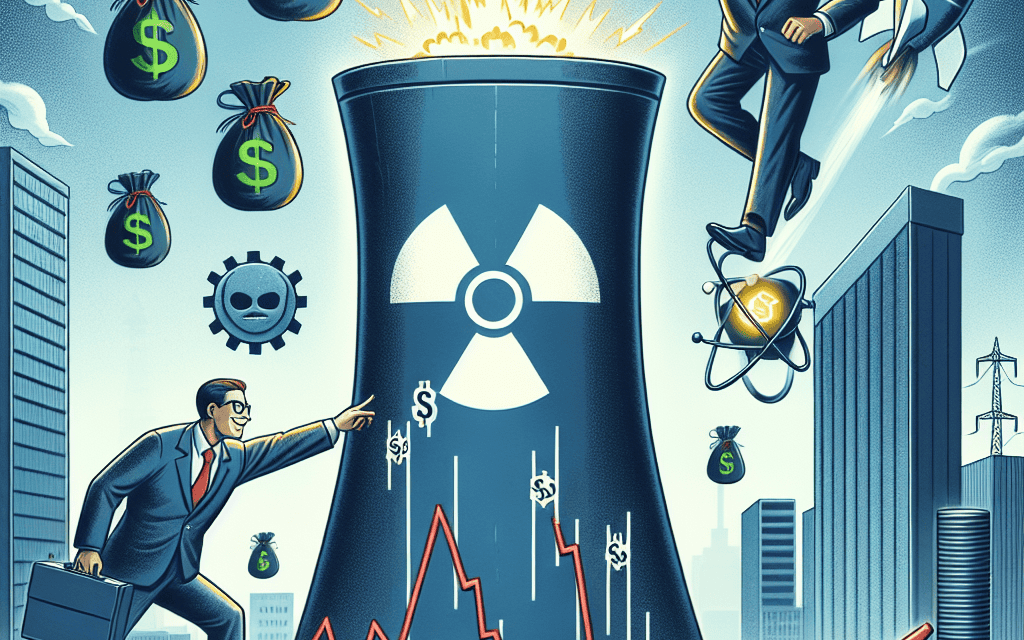“Seize the Future: Invest in Tomorrow’s Energy Today!”
Introduction
In recent years, the quest for sustainable and efficient energy solutions has intensified, drawing significant attention from investors and innovators alike. Among the myriad of emerging technologies, nuclear energy has resurfaced as a promising contender, offering a low-carbon alternative to traditional fossil fuels. One company, backed by visionary entrepreneur Sam Altman, has recently captured the spotlight with its groundbreaking advancements in nuclear technology. This firm has not only doubled its stock value, sparking widespread investor interest, but also raised a critical question: Is it too late to invest in this rapidly ascending nuclear stock? As the world grapples with the urgent need for clean energy, understanding the potential and timing of such investments becomes crucial for those looking to capitalize on the next wave of energy innovation.
Understanding The Recent Surge In Sam Altman-Backed Nuclear Stock
The recent surge in the stock price of a Sam Altman-backed nuclear company has captured the attention of investors and market analysts alike, prompting a flurry of discussions about the potential and timing of investing in this burgeoning sector. As the world increasingly turns its focus towards sustainable and clean energy solutions, nuclear power is once again emerging as a viable option, offering a low-carbon alternative to fossil fuels. This renewed interest in nuclear energy is reflected in the stock market, where companies involved in nuclear technology and innovation are experiencing significant growth.
The company in question, supported by the influential entrepreneur and investor Sam Altman, has recently seen its stock price double, raising questions about whether it is too late for new investors to enter the market. To understand the dynamics at play, it is essential to consider the factors contributing to this remarkable growth. One of the primary drivers is the global push for decarbonization, which has led to increased investment in nuclear technology as countries strive to meet ambitious climate goals. Nuclear power, with its ability to provide a stable and continuous energy supply, is being recognized as a critical component of the future energy mix.
Moreover, advancements in nuclear technology, such as small modular reactors (SMRs) and next-generation reactors, are making nuclear power more accessible and economically viable. These innovations promise enhanced safety features, reduced waste, and lower costs, making them attractive to both governments and private investors. The company backed by Sam Altman is at the forefront of these technological advancements, positioning itself as a leader in the field and attracting significant attention from the investment community.
In addition to technological advancements, policy changes and government support are playing a crucial role in the resurgence of nuclear energy. Many countries are revisiting their energy policies to include nuclear power as a key component of their energy strategy. This shift is driven by the need to reduce greenhouse gas emissions and ensure energy security in the face of growing demand. As a result, companies involved in nuclear energy are benefiting from favorable regulatory environments and increased funding for research and development.
Despite these positive developments, potential investors must consider the risks associated with investing in nuclear stocks. The industry is still subject to regulatory challenges, public perception issues, and the high costs associated with building and maintaining nuclear facilities. Furthermore, the volatility of the stock market means that prices can fluctuate significantly, influenced by external factors such as geopolitical tensions and changes in energy policy.
For those contemplating an investment in this Sam Altman-backed nuclear stock, it is crucial to conduct thorough research and consider both the potential rewards and risks. While the recent surge in stock price may suggest that the opportunity has passed, the long-term prospects for nuclear energy remain promising. As the world continues to grapple with the challenges of climate change and energy security, nuclear power is likely to play an increasingly important role in the global energy landscape.
In conclusion, while the doubling of the stock price may give the impression that the window of opportunity has closed, the underlying factors driving the growth of nuclear energy suggest that there may still be potential for future gains. Investors should weigh the current market conditions against the long-term outlook for nuclear power, considering both the technological advancements and policy shifts that are shaping the industry. By doing so, they can make informed decisions about whether to invest in this promising sector.
Analyzing The Risks And Rewards Of Investing In Nuclear Energy Stocks
Investing in nuclear energy stocks has always been a topic of considerable debate among investors, primarily due to the sector’s unique blend of risks and rewards. The recent surge in a Sam Altman-backed nuclear stock, which has doubled in value, has reignited interest and curiosity among market participants. This development prompts a critical examination of whether it is too late to invest in this burgeoning opportunity or if there remains potential for further growth.
To begin with, the nuclear energy sector is characterized by its potential to provide a stable and substantial energy output with relatively low carbon emissions. This makes it an attractive option in the global push towards sustainable energy solutions. The backing of influential figures like Sam Altman, known for his strategic foresight and successful ventures, adds a layer of credibility and optimism to the stock in question. However, the rapid increase in its value raises questions about the sustainability of such growth and the inherent risks involved.
One of the primary risks associated with investing in nuclear energy stocks is the regulatory environment. Nuclear energy projects are subject to stringent regulations and oversight, which can lead to significant delays and increased costs. These factors can adversely affect the financial performance of companies within the sector. Moreover, public perception and political factors can also influence regulatory decisions, adding an element of unpredictability to the investment landscape.
In addition to regulatory challenges, the nuclear energy sector faces competition from other renewable energy sources, such as solar and wind power. These alternatives have seen significant advancements in technology and cost reductions, making them more accessible and appealing to both consumers and investors. Consequently, nuclear energy companies must continuously innovate and improve their technologies to remain competitive and relevant in the evolving energy market.
Despite these challenges, the rewards of investing in nuclear energy stocks can be substantial. The global demand for clean and reliable energy is on the rise, driven by increasing awareness of climate change and the need for sustainable solutions. Nuclear energy, with its ability to provide a consistent power supply, positions itself as a crucial component of the future energy mix. Companies that can successfully navigate the regulatory landscape and leverage technological advancements stand to benefit significantly from this growing demand.
Furthermore, the involvement of high-profile investors like Sam Altman can attract additional capital and talent to the sector, fostering innovation and growth. This can create a positive feedback loop, where increased investment leads to technological advancements, which in turn attract more investment. For investors, this presents an opportunity to be part of a potentially transformative industry with long-term growth prospects.
In conclusion, while the recent doubling of the Sam Altman-backed nuclear stock may suggest that some of the initial growth potential has been realized, it does not necessarily mean that the opportunity has been exhausted. The nuclear energy sector, with its unique set of challenges and opportunities, continues to hold promise for investors willing to navigate its complexities. By carefully analyzing the risks and rewards, and considering the broader trends in the energy market, investors can make informed decisions about whether to invest in this dynamic and evolving industry.
The Role Of Sam Altman In The Future Of Nuclear Energy Investments
Sam Altman, a prominent figure in the tech industry and a key player in the venture capital world, has recently turned his attention to the nuclear energy sector, sparking significant interest and debate among investors. As the co-founder of OpenAI and former president of Y Combinator, Altman has a track record of identifying and nurturing groundbreaking technologies. His involvement in nuclear energy investments has brought renewed attention to this often-controversial industry, particularly as the world grapples with the urgent need for sustainable and reliable energy sources.
Nuclear energy, long overshadowed by concerns over safety and waste management, is experiencing a renaissance, driven by advancements in technology and a growing recognition of its potential to provide large-scale, low-carbon power. Altman’s backing of a nuclear stock that recently doubled in value underscores the increasing confidence in the sector’s future. This development raises the question of whether it is too late for investors to capitalize on this opportunity. However, understanding Altman’s role and the broader context of nuclear energy investments is crucial for making informed decisions.
Altman’s involvement in the nuclear sector is not merely a financial endorsement but also a strategic move that reflects his belief in the transformative potential of nuclear technology. By leveraging his influence and resources, Altman aims to accelerate the development and deployment of next-generation nuclear reactors, which promise enhanced safety features and greater efficiency. These innovations could address many of the historical challenges associated with nuclear power, making it a more attractive option for countries seeking to reduce their carbon footprints.
Moreover, Altman’s investment strategy aligns with a broader trend of increased interest in nuclear energy from both private and public sectors. Governments worldwide are revisiting their energy policies, recognizing that nuclear power can play a pivotal role in achieving climate goals. This shift in perception is further bolstered by technological advancements, such as small modular reactors (SMRs) and fusion energy, which offer the promise of safer and more flexible nuclear solutions.
For investors, the doubling of the Altman-backed nuclear stock serves as a testament to the growing momentum in the industry. However, it also raises concerns about whether the opportunity has already peaked. While the recent surge in stock value might suggest that the initial wave of investment has passed, it is essential to consider the long-term potential of nuclear energy. The sector is still in its early stages of transformation, with significant room for growth as new technologies mature and regulatory frameworks evolve.
Furthermore, Altman’s involvement brings a level of credibility and visibility that can attract additional investment and talent to the industry. His track record of success in other sectors suggests that his engagement could catalyze further innovation and development within nuclear energy. As such, while the immediate gains from the stock’s recent performance may have been realized, the long-term prospects for nuclear investments remain promising.
In conclusion, Sam Altman’s role in the future of nuclear energy investments is both influential and indicative of a broader shift towards embracing nuclear power as a viable solution to global energy challenges. While the recent doubling of a nuclear stock he backs may prompt concerns about missed opportunities, the ongoing evolution of the industry suggests that there is still significant potential for growth. Investors should consider the long-term trajectory of nuclear energy, taking into account Altman’s strategic vision and the technological advancements that are reshaping the sector.
Market Timing: Is It Too Late To Invest In This Booming Nuclear Stock?

In recent months, the financial markets have been abuzz with discussions surrounding a particular nuclear stock that has captured the attention of investors worldwide. This stock, backed by the influential entrepreneur Sam Altman, has recently experienced a remarkable surge, doubling in value and prompting many to question whether it is too late to invest. As with any investment opportunity, timing is crucial, and understanding the factors driving this stock’s performance is essential for making informed decisions.
To begin with, the nuclear energy sector has been gaining traction as a viable solution to the global energy crisis. With increasing concerns about climate change and the need for sustainable energy sources, nuclear power is being revisited as a cleaner alternative to fossil fuels. This shift in perception has created a favorable environment for companies operating in the nuclear space, leading to heightened investor interest. The stock in question has benefited from this renewed focus, as it is well-positioned to capitalize on the growing demand for nuclear energy.
Moreover, the involvement of Sam Altman, a prominent figure in the tech and investment world, has added a layer of credibility and excitement to this stock. Altman’s track record of backing successful ventures has instilled confidence among investors, who view his endorsement as a positive signal. His involvement suggests that the company may possess innovative technologies or strategic advantages that could drive future growth. Consequently, this has contributed to the stock’s recent surge, as investors seek to align themselves with Altman’s vision.
However, despite the stock’s impressive performance, potential investors must exercise caution and consider several factors before making a decision. Firstly, the nuclear industry is not without its challenges. Regulatory hurdles, public perception, and the high costs associated with nuclear projects can pose significant risks. While the current market sentiment is favorable, any adverse developments could impact the stock’s trajectory. Therefore, it is crucial for investors to conduct thorough due diligence and assess the company’s ability to navigate these challenges effectively.
Furthermore, the recent doubling of the stock’s value raises questions about its current valuation. While the growth potential of the nuclear sector is undeniable, it is essential to evaluate whether the stock’s price accurately reflects its intrinsic value. Investors should consider the company’s financial health, competitive positioning, and growth prospects to determine if the current price offers a reasonable entry point. Overpaying for a stock, even one with strong growth potential, can limit future returns and increase the risk of losses.
In addition, market timing is inherently challenging, and attempting to predict short-term price movements can be a risky endeavor. While the stock’s recent performance may suggest further upside, it is important to adopt a long-term perspective. Investing in a company with solid fundamentals and a promising outlook can yield substantial returns over time, even if short-term fluctuations occur. Therefore, investors should focus on the company’s underlying strengths and its ability to deliver sustainable growth rather than being swayed solely by recent price movements.
In conclusion, while the Sam Altman-backed nuclear stock has undoubtedly captured the market’s attention with its recent surge, potential investors must carefully weigh the opportunities and risks associated with this investment. The nuclear sector’s growing importance, coupled with Altman’s involvement, presents a compelling case for consideration. However, thorough research and a long-term perspective are essential to making an informed decision. By evaluating the company’s fundamentals and understanding the broader industry dynamics, investors can better assess whether it is too late to invest in this booming nuclear stock.
The Impact Of Technological Advancements On Nuclear Stock Valuations
The rapid pace of technological advancements has significantly influenced the valuations of nuclear stocks, particularly those backed by prominent figures such as Sam Altman. As the world increasingly seeks sustainable and efficient energy solutions, nuclear technology has emerged as a promising contender. This shift in focus has led to a surge in interest and investment in nuclear stocks, with some experiencing substantial growth in a relatively short period. A prime example of this phenomenon is a nuclear stock backed by Sam Altman, which recently doubled in value, prompting investors to question whether it is too late to invest.
To understand the impact of technological advancements on nuclear stock valuations, it is essential to consider the broader context of the energy sector. As concerns about climate change and carbon emissions intensify, there is a growing demand for clean energy sources. Nuclear power, with its low carbon footprint and high energy output, presents a viable alternative to fossil fuels. Recent technological innovations have further enhanced the safety and efficiency of nuclear reactors, making them more attractive to investors and policymakers alike.
One of the key technological advancements driving the growth of nuclear stocks is the development of small modular reactors (SMRs). These reactors offer several advantages over traditional large-scale nuclear plants, including lower initial capital costs, shorter construction times, and enhanced safety features. SMRs are designed to be scalable and flexible, allowing them to be deployed in a variety of settings, from remote locations to urban centers. This versatility has captured the attention of investors, who see the potential for widespread adoption of SMRs as a catalyst for growth in the nuclear sector.
Moreover, advancements in nuclear fusion technology have also contributed to the rising valuations of nuclear stocks. While still in the experimental stage, nuclear fusion holds the promise of providing virtually limitless clean energy. Recent breakthroughs in fusion research have brought the technology closer to commercialization, sparking renewed interest and investment in companies working on fusion projects. The potential of fusion energy to revolutionize the energy landscape has not gone unnoticed by investors, who are eager to capitalize on the opportunities it presents.
In addition to technological advancements, government policies and public perception play a crucial role in shaping the valuations of nuclear stocks. Many governments are now recognizing the importance of nuclear energy in achieving their climate goals and are implementing policies to support its development. This includes providing funding for research and development, streamlining regulatory processes, and offering incentives for the construction of new nuclear facilities. Such supportive measures have bolstered investor confidence in the nuclear sector, contributing to the recent surge in stock valuations.
However, despite the promising outlook for nuclear stocks, potential investors must exercise caution. The nuclear industry is not without its challenges, including regulatory hurdles, public opposition, and the high costs associated with nuclear projects. Additionally, the recent doubling of the Sam Altman-backed nuclear stock may have already priced in much of the anticipated growth, raising questions about the potential for further appreciation.
In conclusion, while technological advancements have undeniably enhanced the appeal of nuclear stocks, investors must carefully weigh the risks and rewards before making investment decisions. The recent surge in valuations, driven by innovations such as SMRs and nuclear fusion, reflects the growing recognition of nuclear energy’s potential to address global energy challenges. However, as with any investment, due diligence and a thorough understanding of the market dynamics are essential to making informed decisions.
Diversifying Your Portfolio With Emerging Nuclear Energy Stocks
In recent years, the global energy landscape has been undergoing a significant transformation, with a growing emphasis on sustainable and clean energy sources. Among these, nuclear energy has re-emerged as a viable option, offering a low-carbon alternative to fossil fuels. This resurgence in interest has been fueled by technological advancements and increased investment from influential figures, such as Sam Altman, who have recognized the potential of nuclear energy to address the world’s energy needs. Consequently, investors are now considering whether it is too late to invest in emerging nuclear energy stocks, particularly those that have recently experienced substantial growth.
One such stock, backed by Sam Altman, has recently doubled in value, capturing the attention of investors seeking to diversify their portfolios. The rapid appreciation of this stock raises questions about its future potential and whether it still represents a worthwhile investment opportunity. To address these concerns, it is essential to examine the factors contributing to the stock’s recent performance and the broader context of the nuclear energy sector.
Firstly, the stock’s impressive growth can be attributed to several key developments within the company and the industry at large. Technological innovations have played a crucial role in enhancing the safety and efficiency of nuclear power plants, making them more attractive to investors and policymakers alike. Additionally, the increasing urgency to combat climate change has led to a renewed focus on nuclear energy as a reliable and sustainable power source. These factors have contributed to a favorable market environment for nuclear energy stocks, driving up their value.
Moreover, the involvement of high-profile investors like Sam Altman has further bolstered confidence in the sector. Altman’s backing not only provides financial support but also lends credibility to the company’s vision and potential for growth. His involvement signals to the market that the company is poised for success, attracting additional interest from investors seeking to capitalize on the burgeoning nuclear energy market.
However, despite the stock’s recent success, potential investors must carefully consider the risks and challenges associated with investing in nuclear energy. The industry is subject to stringent regulatory requirements, which can impact the timeline and cost of developing new projects. Additionally, public perception of nuclear energy remains mixed, with concerns about safety and waste management persisting. These factors can influence the long-term viability of nuclear energy investments and should be weighed against the potential rewards.
Furthermore, while the stock’s recent doubling in value is impressive, it is essential to recognize that past performance is not indicative of future results. The stock market is inherently volatile, and fluctuations in value are to be expected. Investors should conduct thorough research and consider their risk tolerance before making any investment decisions.
In conclusion, while the recent surge in value of this Sam Altman-backed nuclear stock may suggest that it is too late to invest, there are still compelling reasons to consider adding nuclear energy stocks to a diversified portfolio. The industry’s potential for growth, driven by technological advancements and a global shift towards clean energy, presents opportunities for investors willing to navigate the associated risks. By carefully evaluating the factors influencing the nuclear energy sector and the specific company in question, investors can make informed decisions about whether this emerging market aligns with their investment goals.
Long-Term Prospects Of Investing In Sam Altman-Backed Nuclear Ventures
The recent surge in the stock price of a Sam Altman-backed nuclear venture has captured the attention of investors and market analysts alike, prompting a critical evaluation of its long-term investment prospects. As the world increasingly seeks sustainable and reliable energy sources, nuclear power is re-emerging as a viable solution to meet global energy demands while reducing carbon emissions. This context provides a compelling backdrop for understanding whether it is too late to invest in this promising sector.
To begin with, the nuclear industry is undergoing a renaissance, driven by technological advancements and a growing recognition of its potential to provide clean energy. Sam Altman, a prominent figure in the tech and investment world, has lent his support to innovative nuclear ventures, signaling confidence in their future. His involvement not only brings financial backing but also adds credibility and visibility to these projects. Consequently, the recent doubling of the stock price can be seen as a reflection of both market optimism and the strategic positioning of these ventures within the broader energy landscape.
However, potential investors must consider several factors before deciding to invest. While the recent stock surge is encouraging, it is essential to assess whether this growth is sustainable in the long term. The nuclear industry, despite its potential, faces significant challenges, including regulatory hurdles, public perception issues, and high initial capital costs. These factors can impact the pace at which nuclear projects are developed and brought to market, potentially affecting the financial performance of companies in this sector.
Moreover, the competitive landscape of the energy market is rapidly evolving. Renewable energy sources such as solar and wind have seen substantial cost reductions and increased adoption, posing a challenge to nuclear power’s market share. Nevertheless, nuclear energy’s ability to provide a stable and continuous power supply remains a critical advantage, particularly as energy grids worldwide strive for reliability amidst increasing demand.
In addition to these considerations, investors should evaluate the specific technological innovations and business models employed by the Altman-backed venture. Companies that are pioneering new reactor designs, such as small modular reactors (SMRs) or advanced nuclear technologies, may offer distinct advantages over traditional nuclear power plants. These innovations promise enhanced safety features, reduced construction times, and lower costs, potentially positioning them as attractive investment opportunities.
Furthermore, government policies and international agreements aimed at reducing carbon emissions could play a pivotal role in shaping the future of nuclear energy. Supportive policies, such as subsidies or tax incentives for clean energy projects, could enhance the financial viability of nuclear ventures. Therefore, staying informed about policy developments and geopolitical factors is crucial for investors considering this sector.
In conclusion, while the recent doubling of the stock price of a Sam Altman-backed nuclear venture is noteworthy, it is not necessarily too late to invest. The long-term prospects of nuclear energy, bolstered by technological advancements and the global push for clean energy, present a compelling case for investment. However, potential investors must carefully weigh the risks and opportunities, considering factors such as regulatory challenges, market competition, and technological innovation. By doing so, they can make informed decisions that align with their investment goals and risk tolerance, potentially capitalizing on the promising future of nuclear energy.
Q&A
1. **What is the company?**
The company is Oklo, a nuclear energy startup backed by Sam Altman.
2. **Why has the stock doubled?**
The stock doubled due to increased investor interest and positive developments in the company’s technology and regulatory progress.
3. **What is Oklo’s focus?**
Oklo focuses on developing small modular reactors (SMRs) for nuclear energy production.
4. **Who is Sam Altman?**
Sam Altman is a prominent entrepreneur and investor, known for his role as the former president of Y Combinator and CEO of OpenAI.
5. **What are the risks of investing in Oklo?**
Risks include regulatory hurdles, technological challenges, and competition in the nuclear energy sector.
6. **What are the potential benefits of investing in Oklo?**
Potential benefits include early entry into a promising technology, support from influential backers, and the growing demand for clean energy solutions.
7. **Is it too late to invest in Oklo?**
It depends on individual risk tolerance and investment strategy, as the stock’s recent surge may indicate both potential and volatility.
Conclusion
Investing in a stock that has recently doubled, such as the Sam Altman-backed nuclear stock, requires careful consideration of several factors. While the recent surge in stock price may indicate strong market interest or positive developments within the company, it also raises questions about whether the stock is overvalued or if the growth is sustainable. Potential investors should evaluate the company’s fundamentals, market position, and future growth prospects. Additionally, understanding the broader industry trends, regulatory environment, and technological advancements in the nuclear sector is crucial. Ultimately, whether it is too late to invest depends on the individual investor’s risk tolerance, investment strategy, and confidence in the company’s long-term potential. Conducting thorough research and possibly consulting with a financial advisor can provide more personalized guidance.





